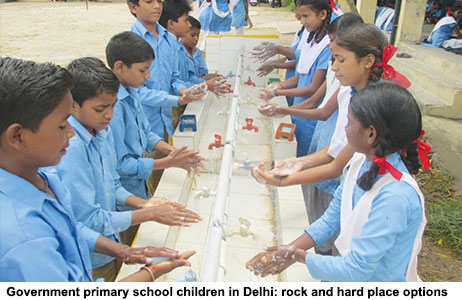
The unlock 4.0 guidelines announced by the Union Ministry of Home Affairs on August 29 which extended the long period (since mid-March) of the closure of all education institutions until September 30, has opened a small window for their early reopening. According to education insiders in the national capital, the Union cabinet has finalised a plan to restart schools and higher education institutions in a phased manner with effect from September 21 until November 14 (Children’s Day).
Under this plan, from September 21, outside local containment zones, 50 percent of teaching and non teaching staff will be permitted to resume offline teaching/telecounseling and related work. Further, under the guidelines, classes IX-XII children will be allowed on a “voluntary basis’’ to visit their schools to seek guidance from teachers. In higher education institutions, research scholars and postgraduate students will have access to laboratories and libraries.
ITIs and other skilling institutions including NSDC-partnered training centres, will also commence gradual re-opening from September 21.
Coterminously, the ministry of health and family welfare is in the process of drawing up broad SOPs (standard operating procedures) for schools and higher education institutions (HEIs) within home ministry guidelines, and a task force appointed by a group of ministers on Covid-19 management, headed by Union health minister Dr. Harsh Vardhan, is working on the modalities of the reopening plan, which is expected to be unveiled by end-September. However, state governments will have the final say in the matter and will calibrate reopening of education institutions in accordance with locally prevailing pandemic conditions. Hill states of north-east India and other states where the virus infection is low will be the first to restart senior schools.
But, informed opinion is unanimous that when schools reopen they should be restricted to class VI upwards, and to a few hours. Also, schools will be advised to run at onethird capacity with students to follow staggered timings as well as alternating school days.
The schools reopening plan has been on the table of several minisdelhi Education News tries for a few months now. A feedback survey of parents conducted by the Union education ministry indicated that the great majority of urban parents are not in favour of reopening until the rising curve of the Covid-19 pandemic is flattened or an anti-coronavirus vaccine becomes available. Ranged on the other side are business/industry leaders who are of the opinion that the toll the pandemic lockdown has taken on livelihoods and the economy is becoming unbearable. A rising number of academics are veering around to this viewpoint as well. They say the loss of learning and emotional/mental damage to students caused by the prolonged national lockdown is also becoming unbearable.
According to Ambarish Rai, national convener of the RTE Forum — a coalition of over 10,000 education NGOs — as acknowledged by NEP 2020, 32 million children are out of school and if they don’t reopen soon, this number will double immediately as 70 percent of the country’s children haven’t been studying for the past six months because of lack of access to online education. “Child labour, trafficking and child marriages have started showing an upward trend and if schools continue to remain closed, this situation is certain to get worse,” says Rai.
Nevertheless implementation of SOPs in government and low-fees BPS (budget private schools) — especially in rural India — is likely to pose a formidable challenge for their managements. Decades of under-funding of public education has taken its toll. According to official DISE data, only 50 percent of the country’s 1.5 million schools have proper drinking water facilities. Although the health ministry’s SOPs have directed district administrations to provide water tankers where there is shortfall or no supply of water, the logistics involved are very challenging.
Dr. Pratibha Singh, WASH (water, sanitation and hygiene education) in Institutions specialist at Unicef, recommends that budgetary provision should be made for rural government schools for introducing WASH facilities. “The current provision of Rs.2,500 for 100 children is completely inadequate. It needs to be doubled,” she says.
However, with the economy contracting by 24 percent in the first quarter of fiscal 2020-21, the Central and state governments are certain to slash — forget about the NEP 2020 recommendation to increase — education outlays. In the circumstances, the children and youth of India are caught between a rock and hard place. If they start school, there’s the danger of Covid-19 infection. If education institutions remain shuttered, tens of millions will suffer irreparable loss of learning and may drop out of the education system. It’s an unenviable dilemma for government and parents.